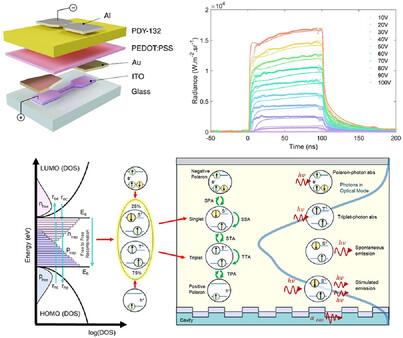电泵浦有机激光二极管的时空激子动力学研究
IF 10
1区 物理与天体物理
Q1 OPTICS
引用次数: 0
摘要
有机材料提供的宽带发射覆盖了传统半导体无法实现的光谱区域。如果使用这些材料可以演示电泵浦激光,就可以实现许多新型光学传感器和探测器,对社会产生深远的影响。由导电分子和聚合物制成的器件已经证明极化子密度高于理论上导致激光作用的极化子密度;然而,门槛仍然难以捉摸。本文报道了一种聚合物微有机发光二极管,其室温电流密度达到了创纪录的1.5,然而,尽管如此,它还不足以达到激光阈值。利用纳秒光谱技术和详细的模拟相结合,揭示了抑制激光作用的机制。结果表明,尽管像以前认为的那样,单重态-三重态湮灭在提高阈值方面很重要,但被激发三重态的光子吸收在抑制激光作用方面同样重要(如果不是更重要的话)。对这些无序材料中的单重态、三重态和自由/激发极化子的复杂动力学进行了可视化;建立克服这些瓶颈的途径,实现电泵有机激光作用。本文章由计算机程序翻译,如有差异,请以英文原文为准。

Unravelling the Spatiotemporal Exciton Dynamics in Electrically Pumped Organic Laser Diodes
Organic materials offer wide‐band emission covering regions of the spectrum unachievable by conventional semiconductors. If electrically pumped lasing could be demonstrated using these materials, many new classes of optical sensors and detectors could be realized leaving a profound impact on society. Devices fabricated from conducting molecules and polymers have already been demonstrated with polaron densities higher than those which theoretically lead to lasing action; however, threshold remains elusive. Herein, a polymer micro‐OLED is reported that achieves record room‐temperature current densities of 1.5 , however despite this, it is not high enough to reach lasing threshold. Using a combination of nanosecond spectrographic techniques and detailed simulation, the mechanisms inhibiting lasing action is unraveled. It is shown that although as previously thought singlet‐triplet annihilation is important in pushing threshold higher, photon absorption by excited triplets is as (if not more) important in inhibiting lasing action. The complex dynamics of singlets, triplets, and free/excited polarons in these disordered materials are visualized; establishing a pathway to overcome these bottlenecks and realise electrically pumped organic lasing action.
求助全文
通过发布文献求助,成功后即可免费获取论文全文。
去求助
来源期刊
CiteScore
14.20
自引率
5.50%
发文量
314
审稿时长
2 months
期刊介绍:
Laser & Photonics Reviews is a reputable journal that publishes high-quality Reviews, original Research Articles, and Perspectives in the field of photonics and optics. It covers both theoretical and experimental aspects, including recent groundbreaking research, specific advancements, and innovative applications.
As evidence of its impact and recognition, Laser & Photonics Reviews boasts a remarkable 2022 Impact Factor of 11.0, according to the Journal Citation Reports from Clarivate Analytics (2023). Moreover, it holds impressive rankings in the InCites Journal Citation Reports: in 2021, it was ranked 6th out of 101 in the field of Optics, 15th out of 161 in Applied Physics, and 12th out of 69 in Condensed Matter Physics.
The journal uses the ISSN numbers 1863-8880 for print and 1863-8899 for online publications.

 求助内容:
求助内容: 应助结果提醒方式:
应助结果提醒方式:


